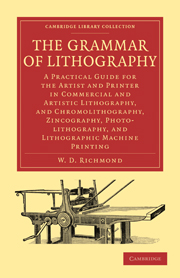 The Grammar of Lithography
The Grammar of Lithography Book contents
- Frontmatter
- Contents
- EDITOR'S INTRODUCTION
- PART I DRAWING, TRANSFERRING AND PRINTING
- CHAPTER I Introductory
- CHAPTER II Mechanical and Chemical Principles of some of the Lithographic Materials used in Printing
- CHAPTER III Instruments, Tools, and Appliances used in Drawing and Writing
- CHAPTER IV Instruments, Tools, and Apparatus used in Printing
- CHAPTER V Accessories to the Lithographic Printing-press
- CHAPTER VI Grinding and Polishing Stones
- CHAPTER VII Lithography on Paper or Transfer Lithography
- CHAPTER VIII Ink Writing and Drawing on Stone
- CHAPTER IX Chalk Drawing on Stone
- CHAPTER X Etching Chalk Drawings on Stone
- CHAPTER XI Taking Impressions for Transferring
- CHAPTER XII Transferring
- CHAPTER XIII Proving and Printing
- CHAPTER XIV Printing (continued)
- CHAPTER XV Printing (continued)
- CHAPTER XVI Miscellaneous Processe
- CHAPTER XVII Miscellaneous Processes (continued)
- CHAPTER XVIII Engraving on Stone
- CHAPTER XIX Zincography
- CHAPTER XX Chromo-lithography
- CHAPTER XXI Chromo-lithography (continued)
- CHAPTER XXII Chromo-lithography (continued)
- CHAPTER XXIII Chromo-lithography (continued)
- CHAPTER XXIV Photo-lithography
- APPENDIX.—Recipes
- PART II LITHOGRAPHIC MACHINE-PRINTING
- BIBLIOGRAPHY OF LITHOGRAPHY
- INDEX
CHAPTER VIII - Ink Writing and Drawing on Stone
Published online by Cambridge University Press: 05 July 2011
- Frontmatter
- Contents
- EDITOR'S INTRODUCTION
- PART I DRAWING, TRANSFERRING AND PRINTING
- CHAPTER I Introductory
- CHAPTER II Mechanical and Chemical Principles of some of the Lithographic Materials used in Printing
- CHAPTER III Instruments, Tools, and Appliances used in Drawing and Writing
- CHAPTER IV Instruments, Tools, and Apparatus used in Printing
- CHAPTER V Accessories to the Lithographic Printing-press
- CHAPTER VI Grinding and Polishing Stones
- CHAPTER VII Lithography on Paper or Transfer Lithography
- CHAPTER VIII Ink Writing and Drawing on Stone
- CHAPTER IX Chalk Drawing on Stone
- CHAPTER X Etching Chalk Drawings on Stone
- CHAPTER XI Taking Impressions for Transferring
- CHAPTER XII Transferring
- CHAPTER XIII Proving and Printing
- CHAPTER XIV Printing (continued)
- CHAPTER XV Printing (continued)
- CHAPTER XVI Miscellaneous Processe
- CHAPTER XVII Miscellaneous Processes (continued)
- CHAPTER XVIII Engraving on Stone
- CHAPTER XIX Zincography
- CHAPTER XX Chromo-lithography
- CHAPTER XXI Chromo-lithography (continued)
- CHAPTER XXII Chromo-lithography (continued)
- CHAPTER XXIII Chromo-lithography (continued)
- CHAPTER XXIV Photo-lithography
- APPENDIX.—Recipes
- PART II LITHOGRAPHIC MACHINE-PRINTING
- BIBLIOGRAPHY OF LITHOGRAPHY
- INDEX
Summary
Drawing and writing on paper having been described in our last chapter, we now proceed to treat of
78. Writing and Drawing on Stone.—The principal difficulty experienced in drawing and writing on stone arises from the necessity of reversing the work, and this, conjoined to the drawbacks of always having to trace work to the stone, and the great bulk and weight of the latter, places working on stone at a disadvantage in comparison with transfer-paper; on the other hand, the accidents to which transfers are liable cause stone to be more generally used in most establishments.
Transfer-paper is more suited to the use of the writing pen than stone; but for the brush, crayon, and mathematical work, the surface of the stone is to be preferred, and it will hereafter be shown that it allows of a greater variety of work than the transfer method.
79. Ink Drawing on Stone,—The Tracing.—In proceeding to work upon stone, the student must bring himself to acknowledge and appreciate the value and importance of a good and correct Tracing, and feel assured that nothing can be gained by neglecting so essential an aid to success. It is made either in pencil or ink, placed in the reversed position upon the stone, and the red chalk tracing-paper with its prepared side downwards, is interposed between it and the stone. The corners are now gummed, pasted, or held down by paper-weights (avoiding the use of wafers), and the work traced over with a HHH pencil, or other hard tracing point, until a facsimile, in red, of the tracing, is transferred to the stone.
- Type
- Chapter
- Information
- The Grammar of LithographyA Practical Guide for the Artist and Printer in Commercial and Artistic Lithography, and Chromolithography, Zincography, Photo-lithography, and Lithographic Machine Printing, pp. 48 - 59Publisher: Cambridge University PressPrint publication year: 2010First published in: 1878


